We all know that wasps have a sweet tooth, as your sugary drink is more than enough to attract the buzzing insect and ruin your nice picnic.
But, did you know that in addition to sweets, these buzzing troublemakers enjoy munching on meat?
Wasps eat meat only when they are in their larval form. Once they enter adulthood, they cease to eat meat and instead feed on a sugar diet which includes honeydew, nectar, and even sugary liquids like soda. As adult wasps, they need to collect meat or parts of insects to take back to their nest to feed the larvae.
Read on to find out the meat-eating habits and patterns of the infamous cousin of the honeybee.
What Do Wasps Eat?
As omnivorous insects, wasps feed on meat as well as a plant-based diet. Adult wasps kill their prey but they do not feed on it. Instead, they feed their young ones which are primarily carnivorous at the larval stage.
The adults capture their prey, kill it and chop it up into small pieces. They then carry the chopped-up bits to their nest to feed their offspring. They have biting mouthparts which explain how they incapacitate their victims.
However, there are species like spider wasps that use the venom to paralyze their victims and carry them alive back to the nest. Their young ones eat the paralyzed prey while it is still alive.
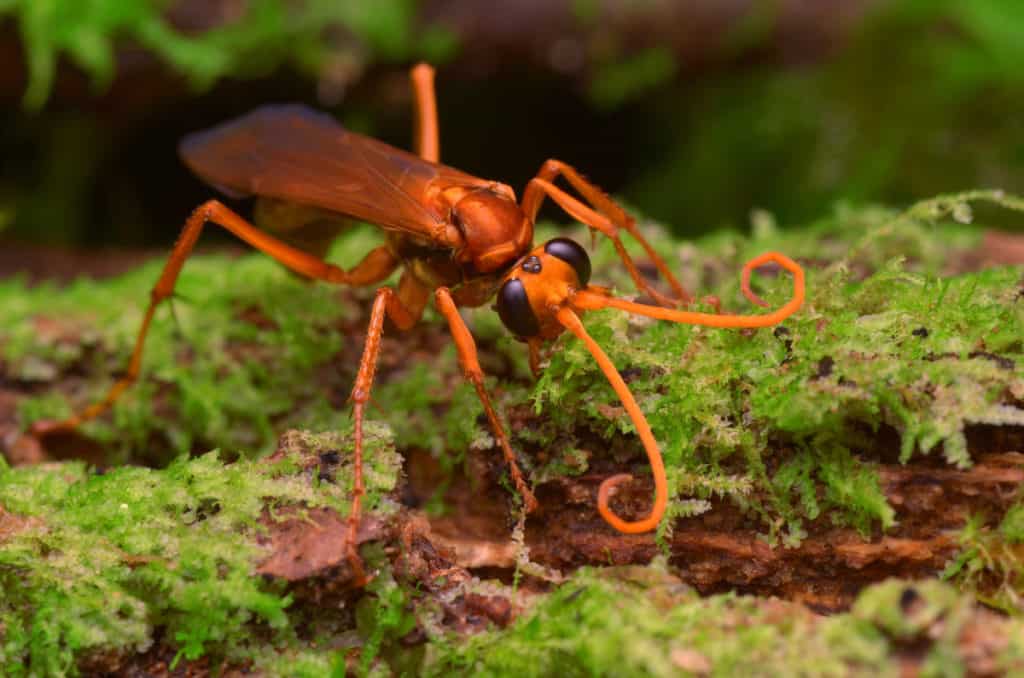
While some solitary species tend to feed their young ones live prey, the eusocial wasps are less brutal and show more mercy to their prey by chopping up their victims before feeding them to the growing offspring.
The solitary species will lay their eggs in the body cavity of their prey and the larvae will hatch and feed on the prey over time eventually killing it.
Both eusocial and solitary adult wasps feed on sugars that they derive from flowers in form of nectar. They also get the sugars from picnic sites where people leave remnants of sugary drinks and other sweet foods.
If you are interested we have written an entire article on the full diets of wasps including one species that takes over the body of cockroaches. The article is called, What Do Wasps Eat?
Which Species Of Wasps Eat Meat?
Before we get started let’s clarify meat is a source of protein and so are other insects. So as we discuss the eating habits of these wasps you will notice that some will capitalize on the opportunity to eat meat as most of us understand it and others will eat other bugs.
Take the definition of meat however you like, I guess some people also replace the traditional meat protein source with bugs like grasshoppers or crickets.
Do Yellowjackets Eat Meat?
Yes, Yellowjackets will eat meat. They will take the opportunity to eat meat we have left around from a picnic or BBQ. Yellowjackets will also eat meat from a carcass of a dead animal. One of their favorites is salmon because of the soft sweet flesh.
The most commonly sighted yellow and black wasps love to frequent picnic areas in the summer and fall where they are attracted to garbage bins. Here they gravitate towards discarded meats and sweets. The yellowjackets carry the food back to the nest for their larvae.
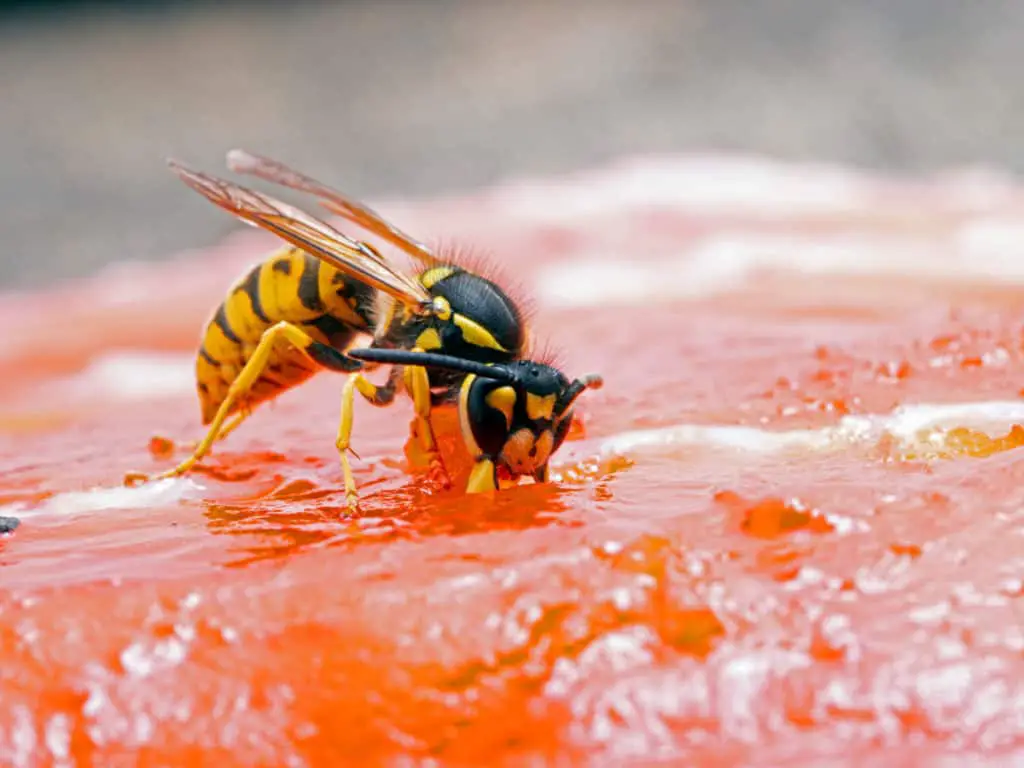
Yellowjackets particularly love salmon because of its high protein content and juicy sweet flesh. The adults also eat fruits and also sweet tree sap. Yellowjackets will even eat soda from the rim of your soda can given the opportunity.
Yellowjackets feed their young protein and will also hunt down beetles, flies, spiders, grubs, and pests like aphids if an easier meal isn’t available.
They are very aggressive and may attack when they are looking for food.
If you would like a detailed look at how yellowjackets compare to other wasps then check out this article we have written, Wasps Vs Yellowjackets.
Do Hornets Eat Meat?
Yes, Hornets will eat meat however they are omnivorous. Hornets will take meat that is left out however they are very efficient hunters of other insects. In fact a group of Giant Asian Hornets can destroy a beehive killing the worker bees to feed on the brood that is high in protein.
Hornets resemble yellowjackets although they are larger in size. Highly accomplished predators, hornets prey on insects like flies and spiders. The Giant Asian Hornets are renowned for attacking beehives belonging to honey bees specifically. The ferocious insects carry the adult bees, their larvae, and pupae as food for their offspring.
This is the only wasp species that goes after bees specifically. The hornets decapitate the heads of the adult bees which defend the hive.
The video below gives a graphic account of how deadly these wasps can be to a beehive.
One giant hornet can kill up to 40 bees in a minute. When one hornet finds a beehive, they leave a special scent to lead the others to the hive’s site. Japanese hornets in particular capture, kill and chew their prey but only to be able to form a gum-like substance which they feed to their larvae.
Also, because of their size (1.5 to 2 inches), they can attack larger prey than most of the wasps. They go after grasshoppers, large butterflies, moths, and crickets. The adult hornets typically feed on nectar, fruits, and leaf sap.
If you would like a detailed look at how hornets compare to other wasps then check out this article we have written, Wasps Vs Hornets.
Do Paper Wasps Eat Meat?
As a general rule, paper wasps don’t feed on discarded meat or carcasses. They prey on other insects or caterpillars as a source of protein to feed their larvae. Adult paper wasps feed on nectar and other sources of sugar like rotting fruit. They do chew wood but only use it to make their nest.
Paper wasps get their name from the paper-like nests. Although they chew it, paper wasps do not use wood as a food source. The wood is chewed up to make it into a pulp that they can use to create their paper nests.
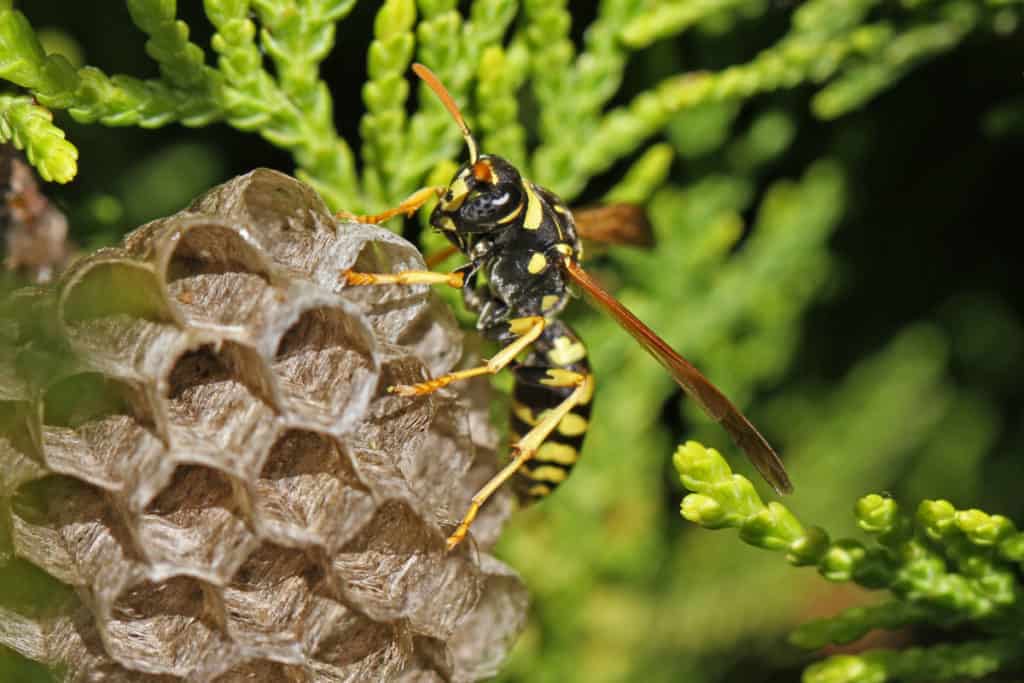
However, like other eusocial wasp species, they feed on sugary foods as adults while providing meat for their larvae to grow. Adults will hover over flowers to get nectar and honeydew or find overripe fruits to eat.
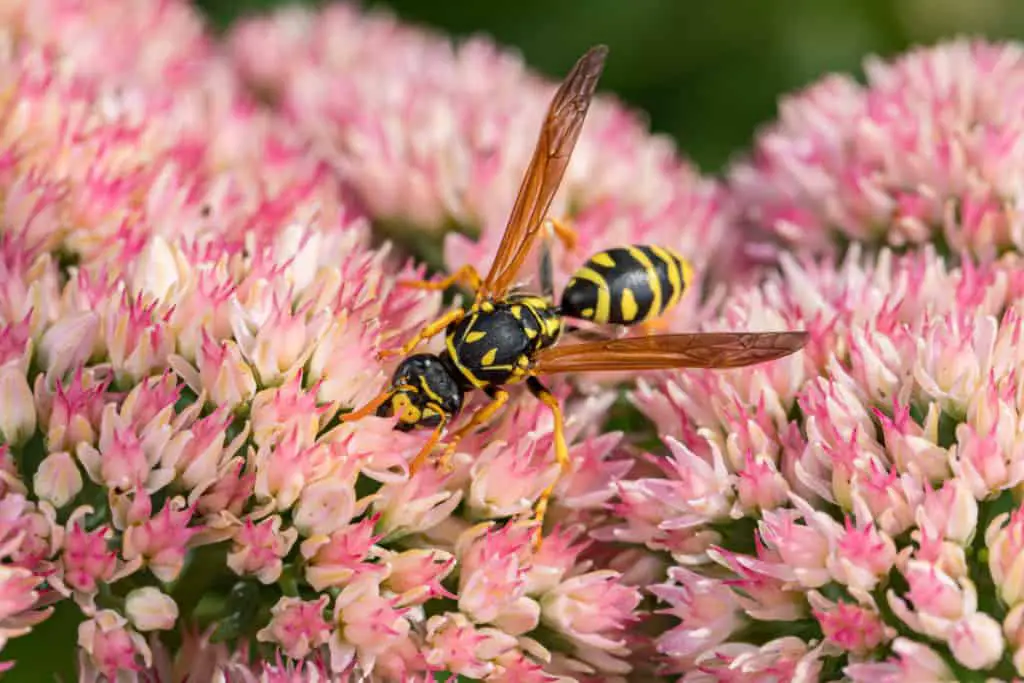
Their prey includes moths, flies, aphids, and caterpillars. The adults also eat the sugary liquid produced by the aphid’s larvae.
Generally, starvation is imminent for wasps if they do not eat within a few days. The larval stage is only 15 days and it is crucial that the larvae have a steady supply of meat to sustain their development.
How Do Wasps Kill Their Prey?
Wasps have stingers that contain venom. The venom is useful as a weapon but it’s also instrumental in hunting. The social wasp’s venom contains philanthotoxins which block the neurotransmitter glutamate found in the insect’s neuromuscular junction. Once the neurotransmitter is blocked it becomes difficult for neuromuscular transmission to occur and without the transmission, the prey’s locomotive abilities are impacted by paralysis.
Species like Ampulex Compressa inject their venom which contains a cocktail of neurotoxins specifically into their prey’s brain. The toxins execute changes in the locomotory behaviors of their victim. These species prey primarily on cockroaches, particularly the American cockroach scientifically known as Periplaneta americana.
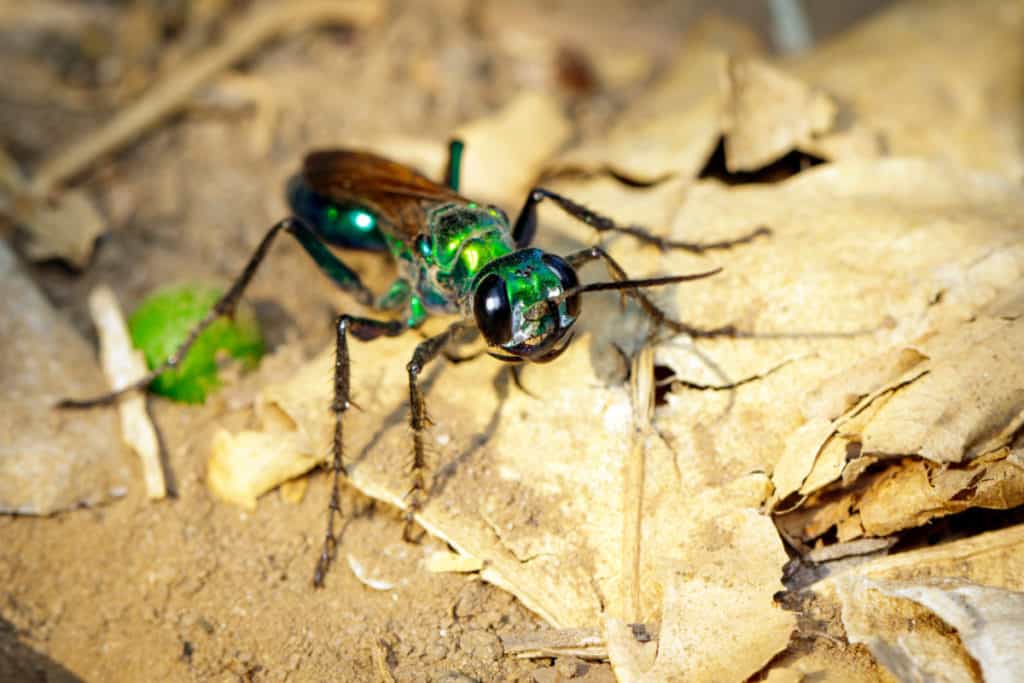
How Often Do Wasps Eat?
Wasps have a rather healthy appetite. Adult wasps have a short life cycle averaging 12-22 days depending on the species. So, they do not have too many days to go without food.
The 22-day life span is typically for a female worker wasp. The drones may live a little longer only to die off when they mate with the queen. The queen lives the longest reaching up to one year.
The lifespan of the colony begins with a new queen mother in early spring when she emerges from hibernation. And it ends in winter when the queen dies off.
There is a bountiful supply of food throughout the spring and fall months that sustain the colony but as the summer peaks. Food sources will begin to drop and by winter there is scarcity that leads to starvation of the entire colony including the queen.
Food is a determining factor in the presence and survival of the colony.
If you are interested we have a detailed article on the life cycle of wasps. The article is called, How Long Does A Wasp Live?
Are Wasps Cannibals?
Cannibalism is the consumption of another individual from the same species as food. And some species of wasps can cannibalize fellow wasps of the same species.
You may notice that a wasp may buzz around a fallen comrade then carry it off. For the wasp, it doesn’t matter what the source of meat is, they will even feed their young ones meat from a fellow wasp.
Why Do Wasps Cannibalize Each Other?
The cannibalistic behavior among wasps was first documented in 1884 in a study where the insects held in captivity turned on each other. A 2006 study published in the Florida Entomologist, proved that the Melittobia Digitata, a parasitic species of wasps, feeds on other adults of its species.
This cannibalistic behavior mainly takes place between males of the species that are known to be very aggressive towards each other and frequently engage in lethal combat. The winner will devour its dead opponents voraciously.
The Vespula vulgaris species, (yellow jackets) also have been reported to indulge in cannibalistic behavior from time to time. They nest underground, in tree cavities, and in buildings where they build huge colonies that feature a good number of insects at any given time. The sudden death of the queen leaves the colony in disarray.
Without unity in the nest, cannibalism can set in as foraging becomes erratic.
Hornets have also been known to cannibalize each other’s colonies. The cause of a disintegrating hornet’s nest is also a dead queen. The queen will die off as the winter approaches leaving younger workers’ hornets and males with a brood to care for.
As the food resources drop with the approaching winter, some worker hornets turn on each other cannibalizing the weaker insects in a futile attempt to feed the remaining brood.
Japanese hornets are more prone to do this. They crush their victim using their strong mandible then tear off their legs, heads, and wings. These hornets are more interested in the nutrient-rich abdomens and thoraxes of their fellow hornets which feed the larvae.
The Wrap Up
Wasps find their food in their environment which is typically subtropical or tropical climates. The good news is that while wasps eat meat, you and I are not at risk of being bitten because they do not depend on blood for survival, unlike mosquitoes and ticks. But it is crucial to take extra precautions when stung by a wasp by monitoring your health for signs of anaphylactic distress.
Adult wasps will eat meat as a last resort when faced with starvation because of little to none of their typical food sources. Remember, they have biting mouthparts so they can feed on meat when the need arises. But under normal circumstances, the meat is food for their larvae.
If you found this interesting you might be interested in one of our other articles below. The meat-eating bees is a fascinating one.
Vulture Bees: There Are Meat Eating Bees And They Make Honey
What Do Spiders Eat? (Their Fascinating Diets Revealed)
What Does A Praying Mantis Eat?
Sources
https://www.nationalgeographic.com/animals/invertebrates/facts/hornets
https://www.nhm.ac.uk/discover/what-do-wasps-do.html
https://www.terminix.com/pest-control/wasps/paper-wasp/identification/
https://www.reed.edu/biology/342_old/assets/readings/EofAB_Libersat_wasps.pdf
